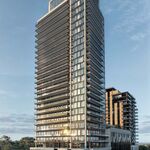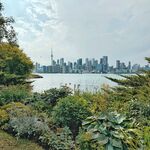Fresh Start
Banned
Objection noted.
The SELRT is going to be a major success, whetever people like it or not. Is it really worth spending energy trying to stop something that will be built?
Typical leftist thinking: my way or the highway.
Objection noted.
The SELRT is going to be a major success, whetever people like it or not. Is it really worth spending energy trying to stop something that will be built?
Last I checked, Sheppard East looks nothing like downtown Ottawa. I am willing to bet real money that curbside bus lanes combined with articulated buses could easily handle 2000 pphpd. It's one bus every 3 minutes or more. Even on that simpleton's graphic the TTC uses, 2000 pphpd falls within the Bus/BRT category. The TTC even suggests that 2000 pphpd is possible in mixed traffic. So I don't know how you can dispute how much it can handle.
http://www.toronto.ca/involved/projects/sheppard_east_lrt/pdf/2008_04-15-17_boards.pdf
See pg. 16. The TTC happens to think that BRT can handle up to 5000 pphpd.
So who's lying? You or the TTC?
Post #80Bus lanes will address demand up to around 2,000pph. Demand on Sheppard east of Don Mills is around 3,000. Your assumption is overly simple.
Until the pavement starts to wear, and potholes appear. The improved ride quality will not last long. Not to mentions buses travelling over the curbside drains. Still a fairly bumpy ride.
The last subway stop on Sheppard is Don Mills. Why you are even including Warden,and Kennedy stations, I have no idea. The demand east of Don Mills Station on Sheppard is projected to peak at 3,000pph. Higher than what bus lanes(without passing lanes) can achieve.
$1 Billion will not build bus lanes on all those arterials. Not by a long shot.
Post #80
When did I say bus lanes could not handle 2,000pph? The TTC also says you need passing lanes, and more infrastructure with BRT for capacity above 2,000.
You, and Gweed do this all the time. You try to twist people's words to suit your argument. It's kind of sleazy.
Yes, lets build mutlibillion dollar light rail schemes because of the discomfort one feels when riding on a bus (though unless one's lucky enough to live, work/school and recreate all along the same corridor they're probably transferring onto a bus anyway).
The TTC also says you need passing lanes, and more infrastructure with BRT for capacity above 2,000.
You, and Gweed do this all the time. You try to twist people's words to suit your argument. It's kind of sleazy.
But that's just it. People don't like the bus and will choose a car over the bus if possible.
But that's just it. People don't like the bus and will choose a car over the bus if possible.
The fact you believe a simple bus lane can carry more than 2,000pph shows just how much you know, and how biased you are.
Any pavement deteriorates with time. But for the same road condition, bus-only lane is somewhat more comfortable than mixed-traffic bus.
In my view, speed is extremely important for transit. Time that I spent on slow transit is time that I could have spent doing something more useful. I do not understand how can people deny that.
Having to commute more than 1 hour each way (2 hours per day) really cuts into your schedule if you have a family and a lot of stuff to do; and makes transit unattractive even for people who would rather not drive.
I do not believe in slow transit. But I do not believe in building a system that focuses solely on speed. A rider is not going to complain about spending 4-5 minutes extra on a vehcile, if it means there is a stop closer to their destination. What do you think people want more: to wait for a infrequent paralell service bus, or the chance to be able to walk home, or to their destination? I'll bet walking.
The steady increase in transit ridership seems to be an indication people are not putting as much emphasis on speed as you think. There needs to be a compromise between speed, accessibility,and convenience. If spending 1 hour on Transit is cutting into your time, than you should honestly invest in a car. It's not right to attempt to cater a small number of long distance riders, at the sacrfice of local, and short-distance riders.
Obviously, people who live near that stop benefit from the stop being added. People who travel by, would likely prefer express ride, but were not asked.
Why should they be asked? They did not request stops to be removed, did they? The point is, people place greater emphasis on conveniene, and accessibilty to a stop, than speed. Even if they got a stop faster, that time savings ls lost due to a longer walk, longer dwell times(more riders at fewer stops).
Either build stations no more than 1 km apart, or use a local bus.
Then the cost increases dramatically. Again, back to the question: Why not just built LRT in surface ROW?
The transfer exists already, no new transfers would be forced. The speed would improve: Warden to Don Mills by bus is 12 - 15 min, by subway it would be 5 - 7 min; and that would help much more people than SELRT.
The speed will also improve with the SELRT, since the LRT will be underground to Consumers Rd, and in Surface ROW eat of Consumers Road. Obviously it will not be as fast as a subway, but it does not have to be. Riders are not going to be concerned about spending a few extra minutes on a vehicle. I do agree with Electrify on thing: If you want significant time savings, the station spacings are going to have to be quite wide.
How else can you travel a large distance within 416 in a reasonable time? Either subway, or fully grade-separate LRT, or GO trains; but the latter do not travel everywhere, and in many corridors, no suitable tracks exist.
How about GO bus? The GO bus travels from STC to York Mills/ Yorkdale, and You can get to York U from STC using the 407 express. This is the role of GO transit, and GO should be petitioned to improve their role in the 416, and provide better service for long distance travellers. You do not need a subway to travel long distances.
There exists a number of routes in 416 where LRT is a right solution, Finch West being one of them. For Sheppard East, LRT is not the optimal solution.
That's fine. I do not think extending the Sheppard Subway is an optimal solution either.I think the SELRT will work just fine.We have our own opinions on what we think works,and I can live with that.
The best investment in transit is the one that provides greatest benefit to greatest number of riders. The northern Scarborough is remote and somewhat isolated geographically from the rest of Toronto. The extension of Sheppard subway would help many people living there to travel to other places in the city. In contrast, SELRT will help smaller number of people (living near Sheppard).
And a 1.1 Billion 14km surface rail line is not going to benefit riders? I do not believe for a second. The SELRT is still going to provide a faster trip than the bus, and riders on intersecting routes can still transfer to the line. It's benefiting a large number of riders at a cost that is affordable. In essence, the SELRT will do what you claim a Sheppard Subway can do but at price we can afford. Again, you are focusing totally on speed. If you think riders will take a bus to a subway, those same riders will take a bus to a surface rail line.
SELRT will be the best solution only if it is both origin and destination for the majority of its riders. I don't think this is the case. Jobs do not concentrate around Sheppard, they are either in downtown or scattered all over the city. Even if there is significant job creation along SELRT, not everybody can live close to work; think for example about families with two bread-winners whose jobs are far apart.
A subway is not going to help those unlucky enough to live from work. If anything attention should be focused on making sure GO provides all day service on the Stouffville line, along with fare integration, so riders have an even quicker ride downtown whose fare is on par, or least only a bit more expensive than the TTC. As I stated before, GO does provide East-West service on it's GO bus routes. Regional long distance travel is the role of GO.
On that point, I have to agree with you. The risk of canceling SELRT and getting nothing in exchange overweights the fact that SELRT is not the optimal investment for this corridor.
At this point, better SELRT than nothing.
Try to make the most of it. I am not a big fan of the Subway to York Region(Should have stopped at Steeles), but it's going to be built, and chances are, I am going to use it when I visit the parents in Brampton.
Perhaps you think that it wasn't worthy of LRT ... but there are even some people out here who look at the relatively low ridership, and actually have the gall to suggest that it should be subway!
A little underdone ... but I'd think Ottawa-style BRT wouldn't actually fit in the alignments being studied, as the roadways are so wide, and the stations are very wide.
Who cares. You guys have been shown to provide misleading assumptions in the past, and you love to insult others, but get offended if anyone calls you out.
The fact you believe a simple bus lane can carry more than 2,000pph shows just how much you know, and how biased you are.
Last I checked, Sheppard East looks nothing like downtown Ottawa. I am willing to bet real money that curbside bus lanes combined with articulated buses could easily handle 2000 pphpd. It's one bus every 3 minutes or more. Even on that simpleton's graphic the TTC uses, 2000 pphpd falls within the Bus/BRT category. The TTC even suggests that 2000 pphpd is possible in mixed traffic. So I don't know how you can dispute how much it can handle.
http://www.toronto.ca/involved/projects/sheppard_east_lrt/pdf/2008_04-15-17_boards.pdf
See pg. 16. The TTC happens to think that BRT can handle up to 5000 pphpd.
So who's lying? You or the TTC?
Typical leftist thinking: my way or the highway.
Post #80
When did I say bus lanes could not handle 2,000pph? The TTC also says you need passing lanes, and more infrastructure with BRT for capacity above 2,000.
You, and Gweed do this all the time. You try to twist people's words to suit your argument. It's kind of sleazy.




